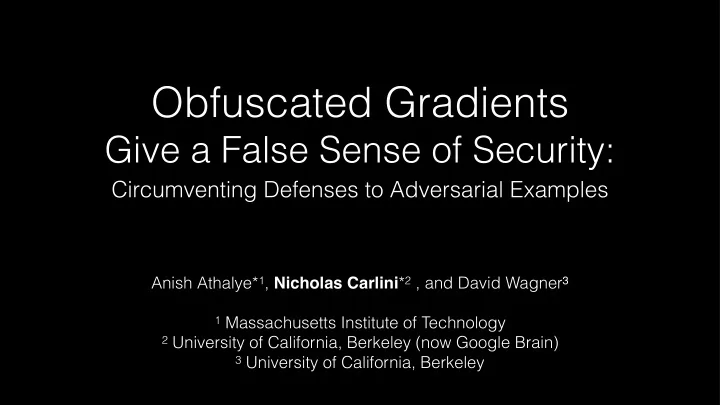

Obfuscated Gradients Give a False Sense of Security: Circumventing Defenses to Adversarial Examples Anish Athalye* 1 , Nicholas Carlini * 2 , and David Wagner 3 1 Massachusetts Institute of Technology 2 University of California, Berkeley (now Google Brain) 3 University of California, Berkeley
Or, Advice on performing adversarial example defense evaluations
Adversarial Examples Definition 2: Definition 1: Given an input x, Inputs specifically find an input x' crafted to fool a that is misclassified neural network. such that |x-x'| < 𝜁 Not complete. Correct definition. Hard to formalize. Easy to formalize.
Adversarial Examples Definition 1 Defn. 2
13 total defense papers at ICLR'18 9 are white-box, non-certified 6 of these are broken (~0% accuracy) 1 of these is partially broken
~50% of our paper is our attacks
~50% of our paper is our attacks This talk is about the other 50%.
This Talk: How should we evaluate adversarial example defenses?
1. A precise threat model 2. A clear defense proposal 3. A thorough evaluation
1. Threat Model A threat model is a formal statement defining when a system is intended to be secure.
1. Threat Model What dataset is considered? Adversarial example definition? What does the attacker know? (model architecture? parameters? training data? randomness?) If black-box: are queries allowed?
All Possible Adversaries Threat Model
All Possible Adversaries Threat Model
All Possible Adversaries Threat Model
Good Threat Model: "Robust when L 2 distortion is less than 5, given the attacker has white-box knowledge" Claim: 90% accuracy on ImageNet
2. Defense Proposal Precise proposal of one specific defense (with code and models available)
3. Defense Evaluation A defense evaluation has one purpose, to answer: "Is the defense secure under the threat model?"
3. Defense Evaluation acc, loss = model.evaluate( Xtest, Ytest) Is no longer sufficient.
3. Defense Evaluation This step is why security is hard
Serious effort to evaluate By space, most papers are ½ evaluation
Going through the motions is insufficient to evaluate a defense to adversarial examples
The purpose of a defense evaluation is NOT to show the defense is RIGHT
The purpose of a defense evaluation is to FAIL to show the defense is WRONG
Actionable advice requires specific, concrete examples Everything the following papers do is standard practice
Perform an adaptive attack
A "hold out" set is not an adaptive attack
Stop using FGSM (exclusively)
Use more than 100 (or 1000?) iteration of gradient descent
Iterative attacks should always do better than single step attacks.
Unbounded optimization attacks should eventually reach in 0% accuracy
Unbounded optimization attacks should eventually reach in 0% accuracy
Unbounded optimization attacks should eventually reach in 0% accuracy
Model accuracy should be monotonically decreasing
Model accuracy should be monotonically decreasing
✓
Evaluate against the worst attack
Plot accuracy vs distortion
Verify enough iterations of gradient descent
Try gradient-free attack algorithms
Conclusion The hardest part of a defense is the evaluation
Thank You Please do reach out to us if you have any evaluation questions Anish: aathalye@mit.edu Me: nicholas@carlini.com
Recommend
More recommend